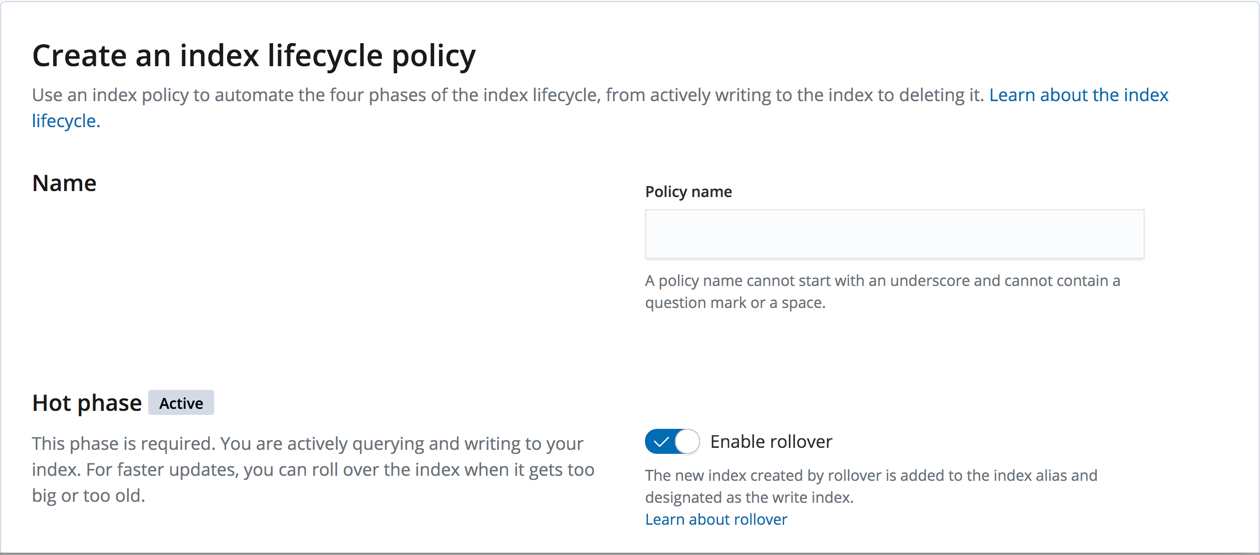Tutorial: Automate rollover with ILM
editTutorial: Automate rollover with ILM
editWhen you continuously index timestamped documents into Elasticsearch, you typically use an index alias so you can periodically roll over to a new index. This enables you to implement a hot-warm-cold architecture to meet your performance requirements for your newest data, control costs over time, enforce retention policies, and still get the most out of your data.
To automate rollover and management of time-series indices with ILM, you:
- Create a lifecycle policy that defines the appropriate phases and actions.
- Create an index template to apply the policy to each new index.
- Bootstrap an index as the initial write index.
- Verify indices are moving through the lifecycle phases as expected.
For an introduction to rolling indices, see Rollover.
When you enable index lifecycle management for Beats or the Logstash Elasticsearch output plugin, lifecycle policies are set up automatically. You do not need to take any other actions. You can modify the default policies through Kibana Management or the ILM APIs.
Create a lifecycle policy
editA lifecycle policy specifies the phases in the index lifecycle
and the actions to perform in each phase. A lifecycle can have up to four phases:
hot, warm, cold, and delete.
For example, you might define a timeseries_policy that has two phases:
-
A
hotphase that defines a rollover action to specify that an index rolls over when it reaches either amax_sizeof 50 gigabytes or amax_ageof 30 days. -
A
deletephase that setsmin_ageto remove the index 90 days after rollover. Note that this value is relative to the rollover time, not the index creation time.
You can create the policy through Kibana Management or with the put policy API. To create the policy from Kibana, go to Management and click Index Lifecycle Policies.

API example
Create an index template to apply the lifecycle policy
editTo automatically apply a lifecycle policy to the new write index on rollover, specify the policy in the index template used to create new indices.
For example, you might create a timeseries_template that is applied to new indices
whose names match the timeseries-* index pattern.
To enable automatic rollover, the template configures two ILM settings:
-
index.lifecycle.namespecifies the name of the lifecycle policy to apply to new indices that match the index pattern. -
index.lifecycle.rollover_aliasspecifies the index alias to be rolled over when the rollover action is triggered for an index.
You can use the Kibana Create template wizard to add the template. This wizard invokes the put template API to create the template with the options you specify.
The create template request for the example template looks like this:
PUT _index_template/timeseries_template
{
"index_patterns": ["timeseries-*"],
"template": {
"settings": {
"number_of_shards": 1,
"number_of_replicas": 1,
"index.lifecycle.name": "timeseries_policy",
"index.lifecycle.rollover_alias": "timeseries"
}
}
}
|
Apply the template to a new index if its name starts with |
|
|
The name of the lifecycle policy to apply to each new index. |
|
|
The name of the alias used to reference these indices. Required for policies that use the rollover action. |
Bootstrap the initial time-series index
editTo get things started, you need to bootstrap an initial index and designate it as the write index for the rollover alias specified in your index template. The name of this index must match the template’s index pattern and end with a number. On rollover, this value is incremented to generate a name for the new index.
For example, the following request creates an index called timeseries-000001
and makes it the write index for the timeseries alias.
PUT timeseries-000001
{
"aliases": {
"timeseries": {
"is_write_index": true
}
}
}
When the rollover conditions are met, the rollover action:
-
Creates a new index called
timeseries-000002. This matches thetimeseries-*pattern, so the settings fromtimeseries_templateare applied to the new index. - Designates the new index as the write index and makes the bootstrap index read-only.
This process repeats each time rollover conditions are met.
You can search across all of the indices managed by the timeseries_policy with the timeseries alias.
Write operations are routed to the current write index.
Check lifecycle progress
editTo get status information for managed indices, you use the ILM explain API. This lets you find out things like:
- What phase an index is in and when it entered that phase.
- The current action and what step is being performed.
- If any errors have occurred or progress is blocked.
For example, the following request gets information about the timeseries indices:
GET timeseries-*/_ilm/explain
The response below shows that the bootstrap index is waiting in the hot phase’s rollover action.
It remains in this state and ILM continues to call attempt-rollover
until the rollover conditions are met.
{
"indices": {
"timeseries-000001": {
"index": "timeseries-000001",
"managed": true,
"policy": "timeseries_policy",
"lifecycle_date_millis": 1538475653281,
"age": "30s",
"phase": "hot",
"phase_time_millis": 1538475653317,
"action": "rollover",
"action_time_millis": 1538475653317,
"step": "attempt-rollover",
"step_time_millis": 1538475653317,
"phase_execution": {
"policy": "timeseries_policy",
"phase_definition": {
"min_age": "0ms",
"actions": {
"rollover": {
"max_size": "50gb",
"max_age": "30d"
}
}
},
"version": 1,
"modified_date_in_millis": 1539609701576
}
}
}
}